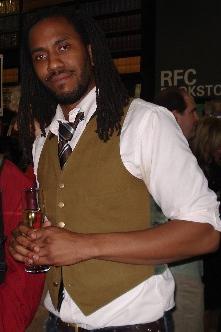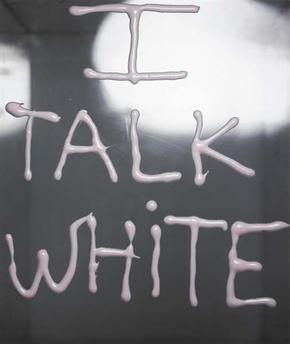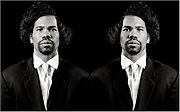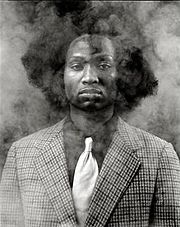Rashid Johnson facts for kids
Quick facts for kids
Rashid Johnson
|
|
|---|---|

Johnson in 2008
|
|
| Born | 1977 Illinois, US
|
| Education | Columbia College Chicago School of the Art Institute of Chicago |
| Occupation | Artist |
| Years active | 1996-present |
| Spouse(s) | Sheree Hovsepian |
| Children | 1 |
| Relatives | Chaka Patterson, brother & Maya Odim, sister |
Rashid Johnson (born 1977) is an American artist. He creates art that makes people think deeply about ideas and feelings. His work often explores themes related to Black history and identity.
Johnson first became well-known in 2001 when he was 24. His art was shown in an important exhibition called Freestyle at the Studio Museum in Harlem. He studied art at Columbia College Chicago and the School of the Art Institute of Chicago. His artwork has been displayed in many places around the world.
Johnson is famous for using different types of art, like photography and painting. He also creates audio art, videos, and sculptures. He is known for his unique art pieces and for mixing science with Black history in his work.
Contents
Early Life and Education
Johnson was born in Illinois. His mother, Cheryl Johnson-Odim, was a professor and scholar. His father, Jimmy Johnson, was an artist who also worked with electronics. His parents divorced when he was two years old. His mother later married a man from Nigeria.
Johnson has said that his family focused on afrocentrism as he grew up. This means they celebrated African culture and history. For example, his family celebrated Kwanzaa, a holiday that honors African heritage.
He grew up in the Wicker Park area of Chicago, Illinois and in Evanston, Illinois. He studied photography and earned his Bachelor of Fine Arts degree in 2000 from Columbia College Chicago. Later, he received his Master of Fine Arts degree in 2005 from the School of the Art Institute of Chicago. A famous artist named Gregg Bordowitz was one of his teachers there.
Johnson grew up at a time when hip hop music and Black Entertainment Television were very popular. This helped him and his audience understand more about the "Black experience" in pop culture. This understanding helps his art connect with people about race and identity.
His art has been shown in many famous museums. These include the Art Institute of Chicago, the Whitney Museum of American Art in New York, and the Metropolitan Museum of Art in New York.
Art Career
Starting His Art Journey
When Johnson was still in college, he had his first art show at the Schneider Gallery. By 2000, he was known for his special way of printing photos and for the political messages in his art. The Freestyle exhibition in 2001 really helped start his career. The curator, Thelma Golden, used the term "post-black art" for the art in that show. This term describes art where race is important, but it's not the only focus.
One of Johnson's early and well-known exhibitions was called Chickenbones and Watermelon Seeds: The African American Experience as Abstract Art. For this show, he used items like watermelon seeds, black-eyed peas, chicken bones, and cotton seeds. He placed them directly onto photographic paper and used a special process to create images.
In 2002, he had an exhibit called Manumission Papers. This name refers to the papers that freed slaves needed to carry to prove they were free. The art in this show was about culture and history. It included abstract shapes of body parts like feet, hands, and elbows. These shapes were arranged into cubes, church windows, and ships. This exhibit made people think about racial identity because the body parts were not clearly identifiable.
Also in 2002, Johnson showed his photographic work using chicken bones at the Museum of Contemporary Art, Chicago. He also displayed art featuring homeless men in an exhibit called Seeing in the Dark. This show used subjects that were only partly lit against dark backgrounds.
In 2004, Johnson had an exhibition called The Evolution of the Negro Political Costume. He showed copies of outfits worn by famous African-American politicians. These included a dashiki worn by Jesse Jackson, a running suit worn by Al Sharpton, and a business suit worn by then-Senator-elect Barack Obama. This display made people think about how political clothing changes over time.
Johnson also explored the idea of "escapism" in a show called The Production of Escapism: A Solo Project by Rashid Johnson. He used photos, videos, and special art setups to explore how people try to escape reality, often with humor.
After Graduate School
After getting his master's degree in 2005, Johnson moved to New York City. He taught at the Pratt Institute. People often call him a photographer or a sculptor, but some also call him an "artist-magician" because of his unique approach.
In 2006, he showed a life-sized photographic self-portrait called Scarecrow. In 2007, his work "Stay Black and Die" was part of The Color Line exhibition. At the same time, he participated in an exhibition about race and sports in America.
As a "post-black" artist, Johnson's art often mixes different materials. His 2008 exhibition The Dead Lecturer played with ideas about race. It included works like The New Negro Escapist Social and Athletic Club (Emmett) (shown on the right). This exhibit imagined a "fictional secret society of African-American thinkers."
Becoming More Famous

In November 2011, Johnson was chosen as one of six finalists for the Hugo Boss Prize, a major art award. In 2012, a big art gallery called Hauser & Wirth announced they would have his first solo exhibition in New York.
In April 2012, the Museum of Contemporary Art, Chicago, held Johnson's first large solo museum exhibition in the United States. It was called Message to Our Folks. This show looked back at ten years of his artwork. A new piece of art, made especially for the museum, was also shown for the first time. The exhibition later traveled to other museums.
In 2013, Johnson was one of the artists chosen for the Performa Biennial, a festival for performance art.
In 2021, the Metropolitan Opera in New York City revealed The Broken Nine. This was a large two-panel artwork made of mosaic, ceramic, and wood. It was created especially for the Opera's grand tier landings. In the same year, Johnson's art was added to the permanent collections of the Museum of Modern Art and the Metropolitan Museum of Art. He also joined the boards of several important art organizations, including the Guggenheim Museum.
In 2022, Johnson's painting Surrender Painting "Sunshine" (2022) sold for $3 million. This was a record price for his art at an auction. Another work, "Carver" (2012), sold for over £264,900 at an auction in London in June 2022.
In the late 2010s, Johnson created several series of works that explored the idea of mental health. These included Anxious Men and Anxious Audiences and Broken Men.
Film Work
Johnson directed his first movie, Native Son. This film was based on the famous 1940 novel of the same name by Richard Wright. The movie was produced by A24 and first shown at the Sundance Film Festival in January 2019. HBO Films bought the movie shortly before its premiere.
Critics had mixed opinions about the film. Richard Roeper gave it a good rating and praised the actors' "electric" performances. Another critic, Jennifer Vineyard, wrote that the movie "isn't a masterpiece" but has "much to admire," like its "striking visual compositions." The website Rotten Tomatoes gave the film a score of 61% based on reviews from many critics. Johnson won an award for "Outstanding Directing in a Motion Picture (Television)" at the 51st NAACP Image Awards for his work on Native Son.
Artistic Style and Methods
Johnson uses ideas from "alchemy, divination, astronomy, and other sciences" that mix natural and spiritual worlds. He uses these ideas to add to Black history in his art. He works with many different materials that have their own meaning. These materials become even more meaningful because of their connection to Black history.
Johnson is known for his unique subjects and his artistic process. Besides portrait photography, he uses a special 19th-century process. This process uses a transparent brown color called Van Dyke brown and sunlight. He applies the color with wide brush strokes, which makes his prints look like paintings. He uses a large camera, which makes him interact closely with the people he photographs.
He also uses materials like shea butter and tiles in his sculptures and mosaics. Shea butter is important to him as a "signifier of African identity." Tiles have a more personal meaning. When he was a student, a Russian and Turkish Bathhouse became a safe place for him. He saw the white tiles there as a canvas for his ideas.
Other Activities
Johnson was part of the jury that chose Otobong Nkanga for the Nasher Prize in 2024.
Personal Life
Rashid Johnson is married to artist Sheree Hovsepian. They live in New York City and have a son.
Awards
- 2012: David C. Driskell Prize
Exhibitions
Johnson has had many solo shows at museums and galleries in the United States and other countries. Some of his notable solo shows include The Rise and Fall of the Proper Negro (2003), The Production of Escapism (2005), Smoke and Mirrors (2009), and Rashid Johnson: Message to Our Folks (2012-2013). More recently, he had Anxious Men (2015), Provocations: Rashid Johnson (2018), The Crisis (2021), and a future show Rashid Johnson: A Poem for Deep Thinkers (2025) at the Solomon R. Guggenheim Museum.
He has also been part of many group shows. These include Freestyle (2001), IBCA 2005 in Prague, ILLUMInations (2011) at the 54th Venice Biennale, and the Shanghai Biennale (2012). He also participated in Prospect. 4: The Lotus in Spite of the Swamp (2017) and the Liverpool Biennial (2021).
Notable Works in Public Collections
- Michael (1998), Art Institute of Chicago
- Calvin (1999), National Museum of African American History and Culture, Smithsonian Institution, Washington, D.C.
- Jonathan (1999), Whitney Museum, New York
- Self-Portrait with my hair parted like Frederick Douglass (2003), Museum of Contemporary Art, Chicago
- The Evolution of the Negro Political Costume (2004), Brooklyn Museum, New York
- Untitled (2007), Seattle Art Museum
- Black Steel in the Hour of Chaos (2008), Whitney Museum, New York
- The New Negro Escapist Social and Athletic Club (Emmett) (2008), National Gallery of Art, Washington, D.C.
- The New Negro Escapist Social and Athletic Club (Thurgood) (2008), Rubell Museum, Miami; and Zeitz Museum of Contemporary Art Africa, Cape Town, South Africa
- Thurgood in the Hour of Chaos (2009), Brooklyn Museum, New York; Fine Arts Museums of San Francisco; Pennsylvania Academy of the Fine Arts, Philadelphia; San Francisco Museum of Modern Art; and Whitney Museum, New York
- The New Negro Escapist Social and Athletic Club (Marcus) (2010), Museum of Contemporary Art, Chicago
- Our People, Kind of (2010), Museum of Modern Art, New York
- The Treatment (2010), Walker Art Center, Minneapolis
- The New Black Yoga (2011), Solomon R. Guggenheim Museum, New York
- River Crossing (2011), Detroit Institute of Arts
- The Sweet Science (2011), Virginia Museum of Fine Arts, Richmond
- Four for the Talking Cure (2012), Los Angeles County Museum of Art
- Tribe (2013), Pérez Art Museum Miami
- Planet (2014), National Gallery of Art, Washington, D.C.
- Fatherhood (2015), Baltimore Museum of Art
- Untitled (2015), Metropolitan Museum of Art, New York; Museum of Fine Arts, Boston; and Whitney Museum, New York
- Untitled Anxious Audience (2017), Milwaukee Art Museum
- Untitled (Anxious Crowd) (2018), Cleveland Museum of Art; Detroit Institute of Arts; and Whitney Museum, New York
- Untitled Escape Collage (2018), Dallas Museum of Art
- The Broken Five (2019), Metropolitan Museum of Art, New York
- Anxious Red Painting November 29th (2020), Art Institute of Chicago
- Stacked Heads (2020), Storm King Art Center, New Windsor, New York
- The Bruising: For Jules, The Bird, Jack and Leni (2021), Crystal Bridges Museum of American Art, Bentonville, Arkansas
- Standing Broken Men (2021), Cleveland Museum of Art
- Untitled Anxious Red (2021), National Gallery of Art, Washington, D.C.




